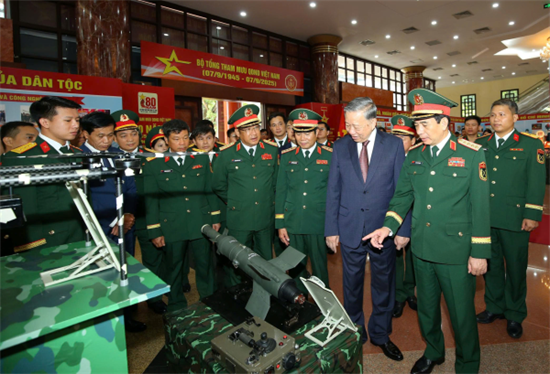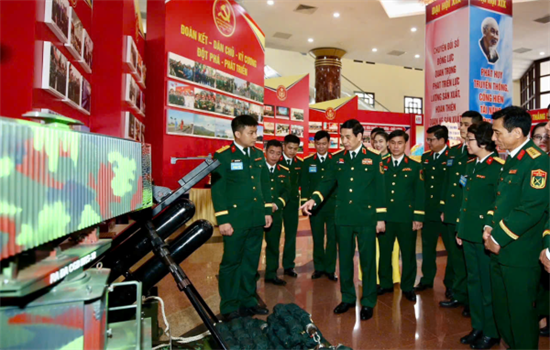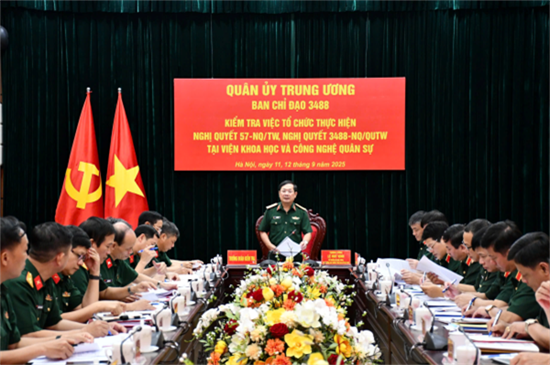Institute of Military Science and Technology accelerates research and development
Over 65 years of building and development, generations of officers, scientists, engineers, and soldiers of the Institute of Military Science and Technology (AMST) have continuously made efforts to research, repair, and develop various types of weapons and technical equipment to meet operational demands across different battlefields. The Institute has become a leading multidisciplinary centre for military scientific and technological research of the Viet Nam People’s Army (VPA). Today, in the face of new requirements, the Institute must further accelerate its research and development efforts in science and technology to meet the increasingly complex demands of building the VPA and defending the Fatherland.
During the resistance war against the U.S. imperialists, to meet the urgent need for research, repair, and development of weapons and technical equipment for the armed forces, on 12 October 1960, the AMST, formerly known as the Department of Technical Research, was established. Over the past 65 years, generations of its officers, engineers, and soldiers have endured countless hardships and sacrifices, demonstrating courage, intellect, and creativity in pioneering military science and technology research. They have made outstanding achievements and important contribution to the growth, combat readiness, and victory of our military.
 |
| Party General Secretary To Lam learns about products developed by the Institute |
Given the spirit of “All for the victory over the U.S. invaders,” the Institute’s officers and engineers set foot across battlefields to study, modify, upgrade, and master various weapons and technical systems as well as design and produce new types of weapons to meet our soldiers’ increasingly modern operational requirements. Outstanding achievements include research projects on neutralising magnetic mines and magnetic bombs, the design and production of barbed wire destruction weapons, DKB staged rockets, low-altitude air-defence systems; the compilation and calibration of A72 shoulder-fired surface-to-air missiles and B72 anti-tank missiles; solutions to disable the McNamara electronic fence; and countermeasures against B-52 jamming, contributing significantly to the nation’s final victory and reunification.
In the period of national construction and defence, the Institute successfully undertook the collection, management, preservation, and research into the use of captured enemy weapons and equipment; and sped up research, development, and transfer of numerous types of weapons and devices to support forces defending the Northern and Southwestern borders as well as to build the VPA in peacetime. In recent years, the Institute has achieved remarkable progress in military science and technology research and development. It has advised and led the implementation of major national and Ministry of National Defence-level scientific and technological programmes; successfully completed hundreds of research projects; mastered many technologies; and created high-tech products that paved the way for designing and manufacturing modern weapons and equipment proudly labeled “Made in Vietnam.” These achievements have greatly strengthened training, combat readiness, and national defence capabilities. Moreover, the Institute has effectively engaged in postgraduate education, developing high-quality human resources in science and technology for the VPA and the country, and accelerating research into new scientific foundations for military application. For its outstanding achievements, the Institute has been awarded the title Hero of the People’s Armed Forces twice, with many organisations and individuals receiving the same honour, the Ho Chi Minh Prize, the State Prize for Science and Technology, and other prestigious awards.
At present, the global and regional situation is evolving in a rapid, complex, and unpredictable manner, with conflicts and wars occurring in many regions. The robust advancement of science and technology, especially artificial intelligence (AI) and new materials, has led to the emergence of increasingly modern, precise, and destructive weapons, as well as new types of warfare. This reality imposes high demands on the task of building the VPA, strengthening national defence, and safeguarding the Fatherland. To contribute to the building of a modern military and firmly defend the nation in the new situation, the Institute aims to continue enhancing comprehensive capabilities, further innovating quality and efficiency in all aspects of work, focusing on mastering some core and fundamental technologies for production of strategic products; researching, designing, and producing high-tech, nationally significant, breakthrough products effectively serving defence and security missions. To realise this objective, the Institute concentrates on implementing the following major solutions.
 |
| General Phan Van Giang, Minister of National Defence, visits the exhibition of the Institute |
First, it is necessary to thoroughly grasp the Party’s guidelines and VPA’s missions, proactively fulfilling its advisory role in scientific and technological development. Accordingly, party committees and commanders at all levels of the Institute continue to rigorously study and execute resolutions and directives of the Party, State, Central Military Commission (CMC), and Ministry of National Defence (MND) on science and technology, particularly the Politburo’s Resolution No. 57-NQ/TW, dated 22 December 2024, the CMC’s Resolution No. 3488-NQ/QUTW dated 29 January 2025, on breakthroughs in scientific and technological innovation and digital transformation within the military, as well as the MND’s Science and Technology Development Strategy to 2030. On the basis of strictly grasping these documents, the Institute coordinates with relevant agencies to assess technologies and advise the General Staff and MND in promulgating and improving the systems of policies, strategies, and development plans for advanced, specialised, and multidisciplinary military technologies; and to modernise weapons and equipment for modern warfare. Futhermore, the Institute resolves to implement its Party Committee’s Resolution No. 1213-NQ/DU, dated 02 April 2025, on breakthroughs in scientific and technological innovation and digital transformation. It closely monitors global military science and technology trends, proactively overcoming difficulties, leveraging advantages, and fostering comprehensive innovation in thinking and methods to make breakthroughs in high-tech research and development such as AI, biotechnology, quantum technology, semiconductors, and strategic weapon technologies in support of domestic development. The goal is to build the Institute into a centre of excellence capable of leading strategic technological development and training high-quality scientific and technological human resources to serve the modernisation of the VPA and defence of the Fatherland.
Second, the Institute promotes research, design, and production of technologically complex, interdisciplinary, and application-oriented products integrated with modern weapons and equipment. This direction is crucial for deepening and improving the practical efficiency of scientific and technological work. The Institute focuses on fundamental and anticipatory research in high-technology fields while intensifying applied research to meet the operational needs of military units. The goal is to design and produce nationally significant, high-tech, and breakthrough products for defence and security, including 4 - 6 new high-tech weapon systems of strategic importance for the military; transfer 250 - 300 new products to military units; lead 5 - 7 national-level science and technology programmes or projects; ensure over 90% of application-oriented research is tested and applied in practice; and complete over 90% of products qualified for initial production and field deployment. Additionally, 5 - 6 specialised research groups in key scientific and technological fields will be established. The Institute also strives to improve intellectual property outcomes—targeting a 20% annual increase in patent applications and a 5% annual rise in granted patents.
Third, there is a need to focus on building high-quality human resources to meet the development demands of military science and technology. In the era of national industrialisation and modernisation, high-quality human resources are vital across all sectors. Given the unique nature and growing demands of building a modern VPA, the development of highly skilled personnel in military science and technology is especially critical. Currently, the military scientific workforce still faces shortages, particularly of leading experts for key programmes and projects, with imbalances across disciplines and notable gaps in age and expertise. Having recognising this, the Institute’s Party Committee and leadership emphasise strong breakthroughs in personnel development, focusing on building a corps of highly competent scientific and technological officers, including chief designers and engineers for weapon systems, who demonstrate political steadfastness, ethics, comprehensive knowledge, professional excellence, dedication to research, vision, and creativity, with the courage to innovate and take responsibility for the collective mission.
 |
| Sr. Lt. Gen. Le Huy Vinh, Deputy Minister of National Defence, works with the Institute |
The party committees and organisations at all levels will map out plans to building and train personnel with appropriate structure and succession, effectively implementing the “Policy on Attracting and Utilising Talent for the Viet Nam People’s Army to 2030, Vision 2050.” Training will be closely linked with research, with a strong emphasise on young scientists, leading experts, design engineers, and technology specialists, forming scientific teams of regional and international calibre capable of addressing military challenges. The Institute also enhances research management through scientific councils, promptly addressing difficulties in ongoing projects to improve research quality and outcomes.
Fourth, the Institute actively invests in infrastructure, technical facilities, and expands international cooperation in military science and technology. It continues to review and plan laboratory systems, focusing investment in high-tech and specialised facilities serving research, design, and production of target products. Priority will be given to establishing new high-tech laboratories and developing digital simulation technologies to shorten research time, reduce costs, and enhance efficiency. In developing its research capacity, the Institute coordinates with national scientific organisations to mobilise resources and technical facilities for key missions, while implementing transparent financial mechanisms for research funding and laboratory management.
Concurrently, the Institute emphasises international integration and cooperation in science and technology, recognising it as the fastest path to accessing global knowledge and advanced technology. Through multiple channels, the Institute expands cooperation in military science and technology, focusing on information exchange, human resource training, acquisition of advanced technologies, and modern management methods from foreign partners, thereby improving the quality of military research and development. Cooperation efforts prioritise identifying suitable partners, adopting “leapfrog” approaches, and concentrating on critical, high-tech sectors to develop weapons and equipment that meet training and operational demands, contributing to building a “revolutionary, regular, elite, and modern” military.
As the nation is entering a new era of development, scientific research and innovation have become strategic pillars of national construction and defence. Proudly receiving the Second-class Military Exploit Order on the occasion of its 65th anniversary, the officers, engineers, and soldiers of the Institute of Military Science and Technology pledge to unite, overcome challenges, and continue reform to build a strong, specialised, and multidisciplinary scientific organisation capable of fulfilling its missions in the new era and forever worthy of the honourable title Hero of the People’s Armed Forces.
Major General, Dr. NGUYEN TRUNG KIEN, Director of the Institute of Military Science and Technology